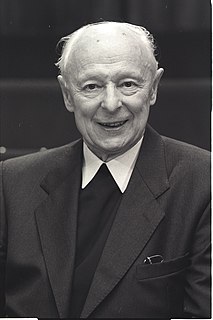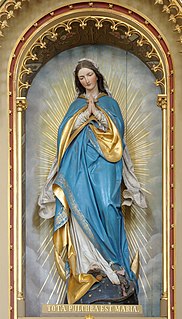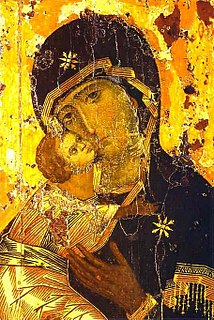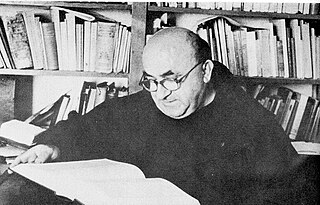The Roman Curia comprises the administrative institutions of the Holy See and the central body through which the affairs of the Catholic Church are conducted. It acts in the pope's name and with his authority for the good and for the service of the particular churches and provides the central organization for the church to advance its objectives.

Catholic Mariology is Mariology in Catholic theology. According to the Immaculate Conception taught by the Catholic Church, she was conceived and born without sin, hence Mary is seen as having a singular dignity above the saints, receiving a higher level of veneration than all angelic spirits and blessed souls in heaven. Catholic Mariology thus studies not only her life but also the veneration of her in daily life, prayer, hymns, art, music, and architecture in modern and ancient Christianity throughout the ages.

A pontifical academy is an academic honorary society established by or under the direction of the Holy See. Some were in existence well before they were accepted as "Pontifical."

Leo Scheffczyk was a German cardinal and theologian. He was a long-time theologian at the Congregation for the Doctrine of the Faith and one of the strongest advocates for orthodoxy during the long pontificate of John Paul II. During the 1980s and 1990s, he severely criticized some of his former students, e.g. Leonardo Boff, who advocated a Marxist version of liberation theology. Scheffczyk likely played a major role in drafting the most controversial documents, such as Ordinatio sacerdotalis and Ad tuendam fidem. He was made a cardinal in 2001. He was regarded as an important thinker in late twentieth-century Catholicism.

The Pontifical Academy of Saint Thomas Aquinas is a pontifical academy established on 15 October 1879 by Pope Leo XIII, who appointed two presidents, his brother Thomist Giuseppe Pecci (1879–1890) and Tommaso Maria Zigliara, professor of theology at the College of Saint Thomas.

Father René Laurentin was a French theologian. He is widely recognized as "one of the world’s foremost students" of Mariology and is the author of numerous books and scholarly articles on topics including Marian apparitions such as Lourdes and Medjugorje; visionaries and mystics including Bernadette Soubirous, Thérèse de Lisieux, Catherine Labouré, and Yvonne Aimée de Malestroit; as well as biblical exegesis, theology, and Vatican II.

Gabriel Maria Roschini, OSM, was a Roman Catholic Italian priest and professor of Mariology, who published over 900 titles on the subject. During the pontificate of Pope Pius XII, he worked closely with the Vatican on Marian publications.

The Marianum is a pontifical institute in Rome, Italy founded by Gabriel Roschini for the study of Mariology.

Mariology is the theological study of Mary, the mother of Jesus. Mariology seeks to relate doctrine or dogma about Mary to other doctrines of the faith, such as those concerning Jesus and notions about redemption, intercession and grace. Christian Mariology aims to place the role of the historic Mary in the context of scripture, tradition and the teachings of the Church on Mary. In terms of social history, Mariology may be broadly defined as the study of devotion to and thinking about Mary throughout the history of Christianity.

The history of Catholic Mariology traces theological developments and views regarding Mary from the early Church to the 21st century. Mariology is a mainly Catholic ecclesiological study within theology, which centers on the relation of Mary, the Mother of God, and the Church. Theologically, it not only deals with her life but with her veneration in life and prayer, in art, music, and architecture, from ancient Christianity to modern times.

The Mariology of the popes is the theological study of the influence that the popes have had on the development, formulation and transformation of the Roman Catholic Church's doctrines and devotions relating to the Blessed Virgin Mary.

The Pontifical Academy of Fine Arts and Letters of the Virtuosi al Pantheon is one of the Pontifical Academies under the direction of the Holy See. The complete Italian name of the academy, Pontificia Insigne Accademia di Belle Arti e Letteratura dei Virtuosi al Pantheon, includes the adjective insigne (illustrious), often omitted in official English translations. The term Virtuosi al Pantheon is also usually left untranslated, but, in any event, should not be taken in the English musical sense of “virtuoso” but rather “artists of great merit”. The Pantheon in Rome was the historical home of the academy. The term “academy” is meant in the Renaissance definition of the term as an association of learned persons and not an institution of instruction.
The Pontifical Academy of Martyrs is one of the ten Pontifical Academies established by the Holy See. It serves to advance the cult of saints and martyrs and the study of related early Christian history, including the catacombs. It operates with guidance and support from the Congregation for Divine Worship and the Discipline of the Sacraments and the Roman Curia.

The Mariological Society of America is a Roman Catholic theological society dedicated to the study of the Blessed Virgin Mary. Each year the society publishes the proceedings of the annual meeting in Marian Studies, a publication that contains articles addressing a particular theme connected to the role of Mary in the spiritual life of the Church, and which is subscribed to by Catholic libraries in various universities and institutions and quoted in the major media.
The Pontifical Academy of Archaeology is an academic honorary society established in Rome by the Catholic Church for the advancement of Christian archaeological study. It is one of the ten such Pontifical Academies established by the Holy See.

The Pontifical Academy of Theology is a learned society founded in 1718, and is a Pontifical Academy. It is situated at Via della Conciliazione, Vatican City, Rome.

Charles Balic was a Croatian Franciscan Mariologist. Friar Charles Balić was a famous Theologian, specializing in the figure and works of John Duns Scotus, and Rector of the Pontifical University Antonianum of Rome. He was the founder of the Pontifical Academy of Mary and President of the International Scotistic Commission. He was the principal redactor in the editing of the chapter VIII of the Lumen gentium with "De Beata" redaction. He has been important for the ecumenical mariology. Balic is considered as one of the top representative of the "Marian movement" in the 20th century: his appointment was conclusive for the proclamation of the dogma of the assumption.
The Pontifical Commission for the Protection of Minors is a pontifical commission within the Roman Curia of the Catholic Church instituted by Pope Francis on 22 March 2014 as an advisory agency serving the pope. Since 5 June 2022, the Commission has been part of the Dicastery for the Doctrine of the Faith, operating with its own officials and according to its own norms.
Praedicate evangelium is an apostolic constitution reforming the Roman Curia and was published and promulgated on 19 March 2022 by Pope Francis; the document took effect on 5 June 2022.
The Dicastery for Culture and Education is an administrative unit of the Roman Curia. It began operations on 5 June 2022 as established by the apostolic constitution Praedicate evangelium promulgated on 19 March 2022. It was formed through the merger of two earlier bodies, the Pontifical Council for Culture and the Congregation for Catholic Education.















